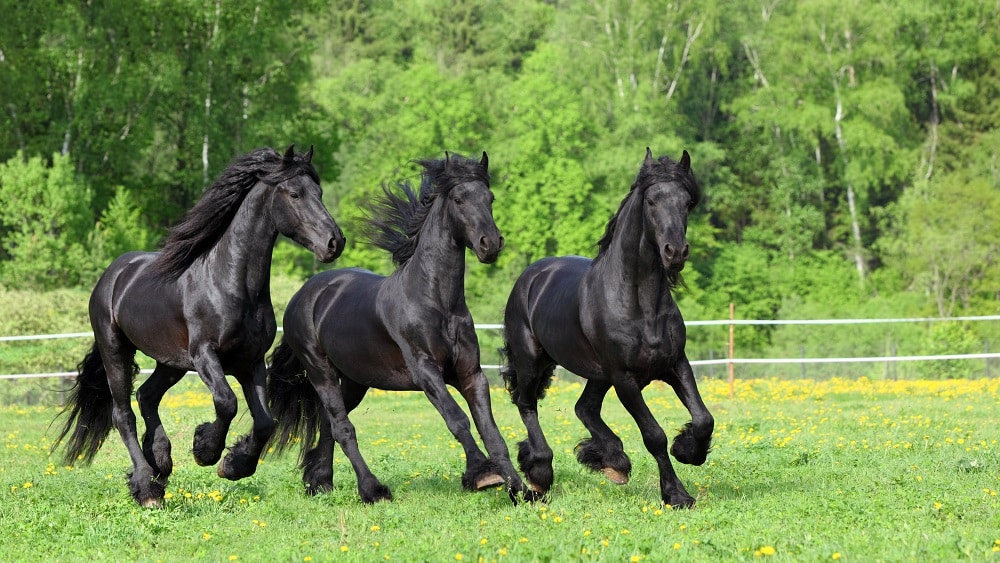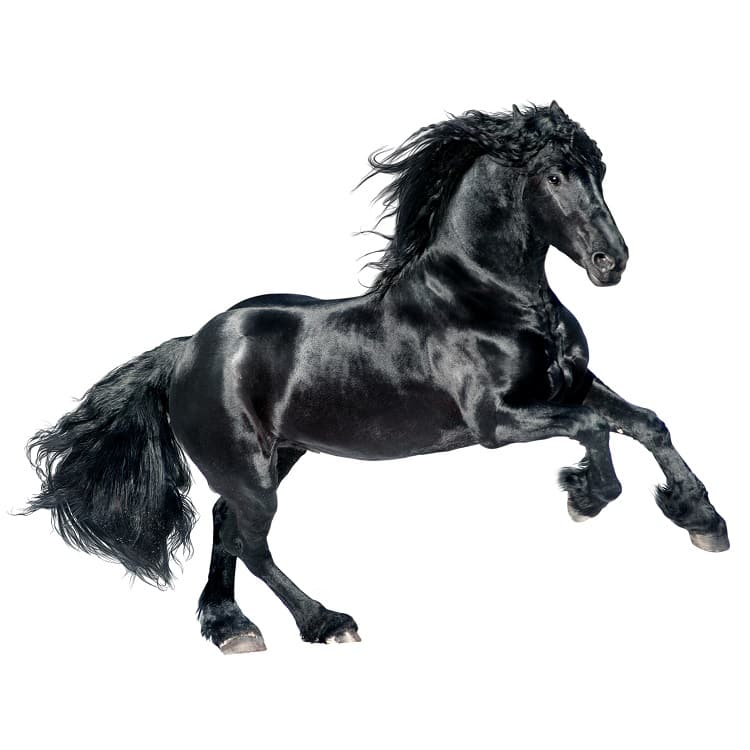
Vital Stats
| WEIGHT: | 544 – 635 kg |
| HEIGHT: | 15 hands – 17 hands |
| LIFE EXPECTANCY: | 16 years |
| BEST FOR: | Leisure riding, competition, cart pulling |
| ORIGIN: | The Netherlands |
Order within 5 hours for Next Day Delivery
The Friesian horse is a large and muscular horse, however its powerful appearance belies an agile equine with a docile and gentle temperament. Originating from Friesland in the Netherlands, the Friesian is also known as a ‘Frizian’, and despite an historic risk of extinction, the breed remains popular in its home country for both leisure and competition riding.
Over the years, the Friesian has been used as a warhorse carrying knights into battle, as well as an agricultural work horse, and even in the circus during the 20th century. However today, they are more often used for recreational purposes; while their striking appearance and calm demeanour has made them a popular choice for film and TV.
Considered to be a warm blooded horse breed, there are two distinct conformation types: the baroque Friesian, with a larger build; and the Friesian sport horse, which has a more lean, fine-boned appearance.


| WEIGHT: | 544 – 635 kg |
| HEIGHT: | 15 hands – 17 hands |
| LIFE EXPECTANCY: | 16 years |
| BEST FOR: | Leisure riding, competition, cart pulling |
| ORIGIN: | The Netherlands |
The Friesian horse originates from Friesland in the Netherlands: a province with a rich equine history. It is said that Medieval knights once chose Friesian horses as their steed for war, while anecdotal evidence suggests that Friesian troops were riding their own horses into battle as early as the 4th century.
Over the years, evolving requirements have changed the characteristics of the Friesian horse, and Friesian stock has been mated with a number of other breeds including Andalusian horses. This lighter Andalusian Friesian cross was popular during the 16th and 17th centuries, however the late 1800s saw a return in focus to pureblood stock.
While the Friesian may have a long reaching history, it wasn’t until 1879 that a studbook society was founded by Friesian farmers and landowners, followed in 1880 by the publishing of a horse stud book.
Around this time, purebred Friesian horses were in very short supply – due in part to the rise in popularity of fellow Dutch horse breed, the Bovenlander. Combined with the rise in use of machinery rather than horses in agriculture and industry, by the early 1900s, there were just three breeding stallions of the Friesian breed remaining.
Numbers recovered throughout the 20th and 21st centuries, and today Friesians make up around 7% of the horses in the Netherlands. They are now ridden for both leisure and competition, and are known for their impressive, powerful stature and glossy jet black coat.
The Friesian horse stands at around 15 – 17 hands high, and weighs in between 544 – 635kg.
To qualify for ‘star-designation’ or as a ‘ster Friesian’, Friesian mares and geldings should be a minimum of 15.2 hands high.
The Friesian horse is muscular and powerful in appearance, and is recognisable for its black colour. It is the jet black Friesian which is most commonly seen: although chestnut Friesians do exist, this is much more rare and usually not accepted by breed registries. Friesians with white markings are rarely seen, and the majority of purebred registries will allow no white markings at all except a small star on the forehead.
In 2007 a white Friesian by the name of Nero was exhibited at Equitana. However, pureblood white Friesians do not exist: Nero was actually 75% Friesian, and 25% Arabian, with this Friesian Arabian cross resulting in a striking white coat.
The classical ‘baroque’ Friesian horse displays a compact, muscular and strong build; while the more modern Friesian sport horse is leaner and fine boned. Their thick, flowing manes and tales are usually wavy; and they display feathering on the lower legs which is often left untrimmed.
Friesian horses are generally easy keepers, which means they require relatively little food and will be happy with a regular equine diet of quality hay, grain, vegetables and fruits. Keep an eye on their intake to avoid them becoming overweight; conversely, Friesian sport horses used for racing may require additional energy to keep them in shape.
Friesian horses will also benefit from the addition of good sources of fat to keep their coats glossy, as well as lots of minerals and vitamins.
The classic Friesian horse is notable for its baroque appearance, while the modern Friesian – often known as the Friesian sport horse – has a more fine boned build. The latter often competes in horse racing, while some individuals can tend to lean more towards the baroque appearance, giving them a unique appearance amongst their peers.
The Friesian horse has a rich history as a war horse, and it is said that even William the Conqueror rode a Friesian. They have also played the part of circus horses in the Circus Strassburger, which began in 1939. Today, Friesian horses can often be seen in film and on tv due to their stunning appearance and calm nature.
The Friesian horse may appear both powerful and majestic, however this belies a gentle, docile temperament. Considered to be a warm blooded breed, the Friesian is willing to learn, intelligent, energetic, and calm.
They do not spook easily, and their desire to please makes them great for competition such as dressage: they are easy to train and suitable for a range of riders.
The Friesian horse is prone to a relatively high number of genetic disorders, which is possibly due to excessive inbreeding, and may contribute towards their shorter lifespan of just 16 years. These include dwarfism, hydrocephalus (a build up of fluid in the brain), aortic rupture, and megaoesophagus (a condition affecting the oesophagus).
Friesian horses are also prone to digestive disorders and skin conditions such as pastern dermatopathy; and can be hypersensitive to insect bites.
The Friesian is a powerful looking horse with a striking appearance – and a grooming regime to match. Their glossy black coats and long, flowing manes and tails are the pride of many an equestrian, and keeping them looking at their best comes with a rigorous grooming regime.
This high maintenance horse requires daily grooming for both health and beauty: the Friesian has dry skin and a susceptibility to rashes which means they need regular care and attention. Their feathers should be washed on a regular basis; while owners should avoid turning out in bright sunlight to stop the sun from bleaching their glossy black coats.
Friesian horse owners may also want to add a colour enhancing shampoo into their grooming kit, as well as one formulated for dry skin.
When it comes to the long, thick mane and tail of the Friesian horse, daily brushing is needed to avoid knots; some owners like to braid their Friesian’s hair to avoid tangles.
The typical lifespan of a Friesian horse is around 16 years, although individuals can live to around 25 – 30 years old.
They may be high maintenance, but what a Friesian horse takes in time it returns in temperament, appearance and skill. Often seen at events including dressage and horse racing, the Friesian makes an impression with its elegant looks and striking black colour.
The Friesian horse is also a popular recreational horse. Its gentle nature and desire to learn make it great for riders of all levels – although their daily grooming requirements mean they may be better suited to experienced horse owners.
In a nod to their history as a draught horse, Friesians are still used to this day to pull sjees (carriages traditionally pulled by Friesian horses), particularly in events and at shows.
Friesian horses have also become a popular choice for filmmakers, due to their stunning appearance and calm nature, which makes them suitable for busy film sets.
